The Florida Department of Management Services (DMS) manages the Capitol Complex, including the grounds of the Historic Capitol. Please direct any inquiries or requests to use outdoor spaces at the Museum to DMS.
http://www.dms.myflorida.com/
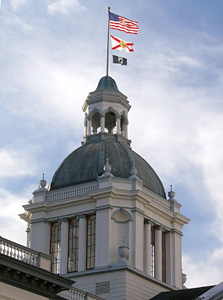
Exterior 1 Cupola and Dome
 Since 1845, state employees and local residents have known that the Capitol roof offers a great view of the surrounding area. In the 1902 additions, architect Frank Milburn added the large dome with cupola and it became a local tradition to climb to the top. In fact, it was such an important part of Tallahassee that local citizens asked for and received an observation deck on the top of the new Capitol.
Since 1845, state employees and local residents have known that the Capitol roof offers a great view of the surrounding area. In the 1902 additions, architect Frank Milburn added the large dome with cupola and it became a local tradition to climb to the top. In fact, it was such an important part of Tallahassee that local citizens asked for and received an observation deck on the top of the new Capitol.
One of the first people to climb to the cupola in the Historic Capitol was Civil War Veteran Major Robert Gamble of Tallahassee. Nearly ninety years old in 1902, he had to climb a maze of ladders, stairs and entryways to reach the top. A comparable experience would be to climb the 22 stories to the top of the New Capitol.
It is 168 feet from ground level to the top of the cupola. The United States, State of Florida and MIA Flags are all-weather flags that are flown every day.
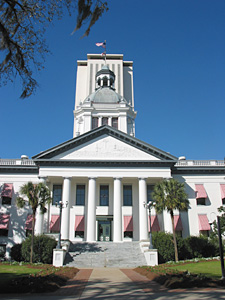
Exterior 2 East Portico
The East entrance reflects the 1902 design by architect Frank Milburn and includes the original granite steps, two electroliers, and six Doric columns. Above the East Porch is the original sheet metal relief of the state seal. Architect Frank Milburn originally added this relief in 1902 and had it painted white to blend in with the exterior of the building. However, after Milburn left, Governor Jennings had it repainted in "natural" colors. In the 1980s, the seal was restored to its original white color.
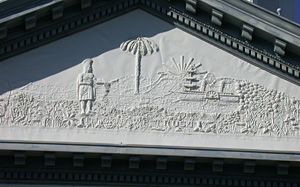
For about seventy years two cannons, both Civil War mountain howitzers, stood on the east stairs of the Capitol and many Tallahassee children used to play on them. In 1979, they were given to the Museum of Florida History and one cannon was displayed in their Civil War exhibit. In September 2008 the second cannon was finally brought back to the Historic Capitol and is on display in Room 120.
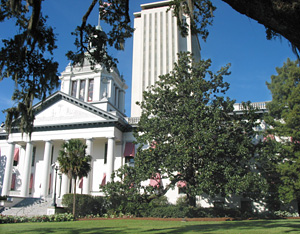
Exterior 3 Magnolia Tree
This magnificent magnolia has been associated with the Capitol for over a century. It first appeared in photos around 1905 when it was already reaching the roofline. It is estimated to be around 120 years old. For years it was traditionally decorated with white lights for the holidays.
This stately southern magnolia is one of the most photographed and recognized trees in the State of Florida.
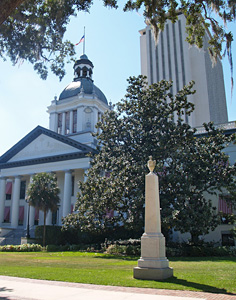
Exterior 4 Confederate Monument
This monument was dedicated in 1882 to Confederate Soldiers from Leon County. The Civil War battles that they participated in are listed on the four sides of the base. It was originally placed on the west side of the Capitol and moved to its present location in 1923.
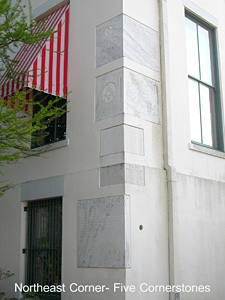
Exterior 5 Cornerstones
These are the four original cornerstones for the 1902, 1923, 1936 and 1947 additions to the Capitol along with a memorial plaque about the building. In 1980, all the cornerstones from the earlier additions were placed in the northeast corner of the restored Capitol.
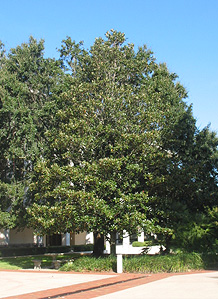
Exterior 6 Andrew Jackson Magnolia
This magnolia tree was grown from a cutting taken from one planted at the White House by Andrew Jackson. The picture of the White House on the twenty dollar bill includes President Jackson's magnolia tree. The small marker is almost hidden in the foliage at the bottom of the tree.
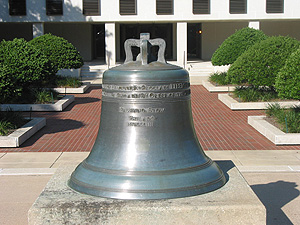
Exterior 7 Liberty Bell Replica
This copper alloy replica of the Liberty Bell was made in France and matches the exact size and tone of the original. It was given to the State of Florida by the U.S. Treasury Department in 1950 as part of a bond drive.
The Liberty Bell was originally placed in the Historic Capitol, but concerns about its weight caused it to be moved to Waller Park, which is now where the new Capitol stands. It was moved to its present location, in front of the House Office Building, around 1980.
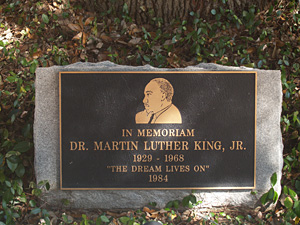
Exterior 8 Martin Luther King Memorial
In 1984, this memorial honoring Dr. Martin Luther King, Jr. was placed in the Capitol courtyard. Dr. King was in Florida at times during the Civil Rights Movement. Addressing marchers in St. Augustine, in 1964, he said, "We are at the most difficult moment. We must remain calm and not let them provoke us into violence."
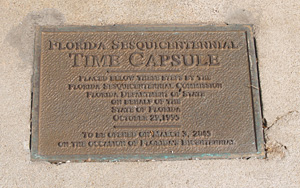
Exterior 9 Sesquicentennial Time Capsule
This time capsule was dedicated and then placed under the west side steps of the Historic Capitol by the Florida Sesquicentennial Commission in 1992. It is to be opened in 2045.
Items placed in the time capsule were chosen to reflect Florida life in 1995. Among those 128 items are a Florida Sesquicentennial T-shirt, a Florida State flag, toothbrush, grocery receipt, toy manatee, Seminole doll, and a 1994-1995 Florida Vacation Guide.
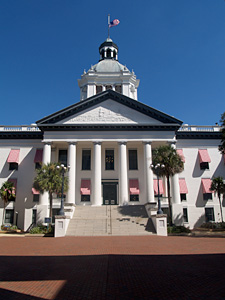
Exterior 10 West Portico
This is the west side of the Historic Capitol from the east entrance of the new Capitol. From 1845 until 1922 the Florida Capitol was symmetrical. This was changed in 1923 with the addition of a west wing. That wing reached right up to the entrance of the new Capitol and was removed during the 1980s restoration.
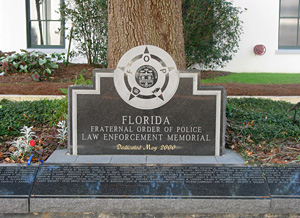
Exterior 11 Law Enforcement Memorial
This memorial was dedicated to fallen law enforcement officers of Florida by the Florida Fraternal Order of Police in May 2000. Engraved on the granite perimeter of the flower bed are the names of law enforcement officers killed in the line of duty, including federal officers assigned to Florida. Sadly, new names are added each year in a memorial service. Visitors are asked to be respectful of this memorial and to not sit or stand on it.
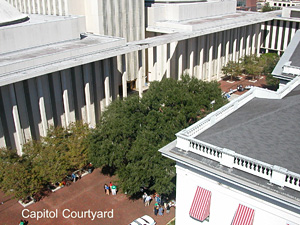
Exterior 12 West Courtyard
This beautiful courtyard between the Historic Capitol and the new Capitol is a busy public area. On any given day you might encounter a press conference, a special bill-signing ceremony with the Governor, people exercising their first amendment rights or a special events day concerning everything from space day to elders day. During the 2000 election, each of the major news organizations did interviews and broadcasts from this courtyard, and had their own specific area laid out with black tape.
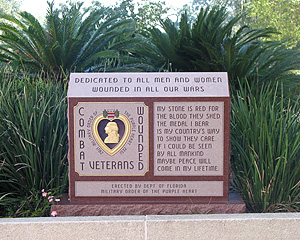
Exterior 13 Combat Wounded Veterans Memorial
On August 7, 2004, the first Purple Heart Memorial Monument in the State of Florida was dedicated to recipients of this award. United States military members from the Revolutionary War to Iraqi Freedom have been awarded the Purple Heart medal. Governor Jeb Bush and the Florida Cabinet passed a resolution officially designating August 7, 2008 as Purple Heart Day.
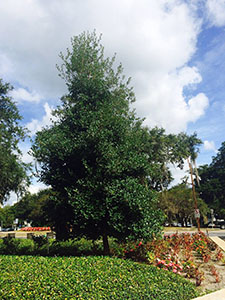
Exterior 14 Washington Holly
This holly tree was grown from a cutting taken from a tree planted by George Washington at Mount Vernon. There was another tree planted near this spot that also related to America's first President. In 1932, an American Elm was planted in this corner of Capitol Square in honor of the bicentennial of George Washington's birthday. State employees each donated a nickel for the elm tree, which died sometime in the 1990s.
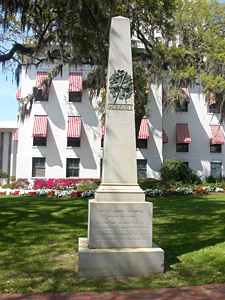
Exterior 15 Parkhill Monument
This is the oldest monument on the Capitol grounds. It was dedicated in 1861, by the citizens of Leon County, to Captain John Parkhill. He was killed at the battle of Royal Palm Hammock on November 28, 1857, during the Third Seminole War. The front of the base is inscribed with the following: "This monument is erected by his fellow citizens of Leon County Florida as a testimonial of the high esteem for his character and public services."
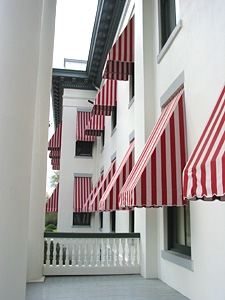
Exterior 16 Awnings
The Historic Capitol's distinctive red and white awnings were used from the 1890s to the early 1920s. They were placed back on the building during the restoration in the 1980s. Since the Historic Capitol faces east and west and receives direct sunlight throughout the day, many types of window protection were used over the years including shades, blinds, shutters and awnings.
Jump to Top of Page























